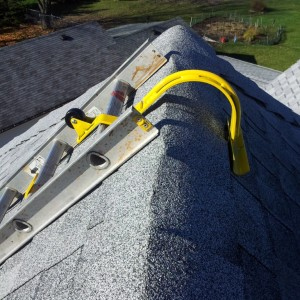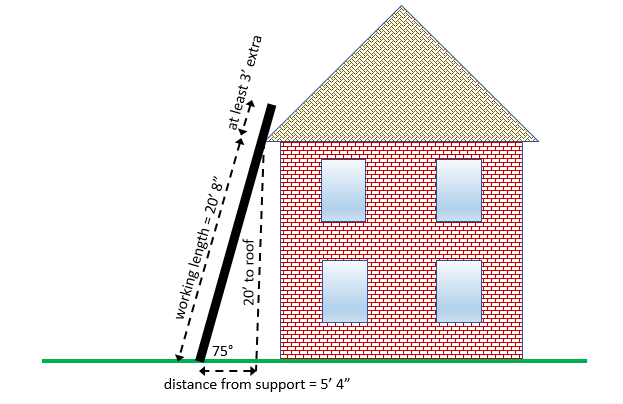DIY Guide to Fall Prevention: Roof Safety Tips
| . Posted in News - 2 Comments

Acro Building Systems sells a good example of a roof hook. These hooks are quoted, but typically less than $100 each. http://www.acrobuildingsystems.com/product/ladders-and-accessories/reinforced-ladder-hook-with-fixed-wheel-swivel-bar
These roof safety tips and OSHA ladder safety explained will help DIY landlords be safe, or else decide to hire.
We all know that houses break over time. Roofs, chimneys, and gutters are no exception. Big jobs qualify for professional assistance, but what about the jobs too small to get anyone’s attention? There are lots of quick fixes for which you will struggle to hire. Your choice is either to pay more than it should cost, to wait until it becomes a big problem, or to climb a ladder yourself. If you decide to climb, you must heed these roof safety tips.
Disclaimer: Although we have endeavored to be accurate, MassLandlords makes no warranty that the information contained in this article is complete or correct. Accidents can occur even if safe practices are observed. Always consult a professional about your particular situation, and if unsure, keep yourself away from heights until a professional can be called in.
Falling Accidents are Common, and Commonly Fatal
In our own MassLandlords network, a well-loved and appreciated Worcester member (who we will allow to remain anonymous) was, at time of writing, still in critical condition after a rooftop fall they suffered on the job earlier this summer. This article is dedicated to them in the hopes that it will prevent a similar accident.
Falling is a serious health risk. Worldwide 556,000 people died from falls in 2013. Falling is alternately the second or third leading cause of accidental death each year behind poisoning (prescription drug overdoses) and car crashes. Falling can lead to paralysis, brain injury, loss of vision or sense smell, and many other near-fatal conditions.

Based on the OSHA ladder safety diagram, with sample figures and angle filled in. Check our math before using.
Best Ladder Safety Tips from OSHA
The Occupational Safety and Health Administration has its eye out for landlords and contractors! Here are their top ladder pointers, paraphrased and expanded:
Ladders should be set so that they extend at least three feet beyond the support. See figure. They should be pitched so that for every four feet of working length, you have one foot of ground distance from the support.
When on a ladder, always face the steps, keep the center of your body between the verticals, and keep three points on the ladder. If you need to reach to one side or the other, do so with only one limb at a time, and never lean past a vertical.
Inspect the ladder. If it looks broken in some way, get a different ladder.
Never place a ladder on boxes, barrels, tarps, or other unstable or slippery surfaces. If you need height, get a taller ladder. If you need the ground to be covered, set the ladder on the ground itself, never on the tarp, and place multiple tarps around the ladder feet.
When other people are nearby, have someone hold the base of the ladder to prevent passers-by from bumping it.
Never use a step ladder in a folded position. They are designed differently and will slip before a straight ladder.
Never stand on the top rung or step unless it says, “Safe to stand on top rung” or similar.
When working near power lines, always use a fiberglass or wood ladder (fiberglass will be much lighter to carry). Never use aluminum near power lines. Electricity can ark several feet through the air even if you don’t hit a line. How can you tell if you’re near power lines? Imagine the ladder falling sideways; if it would pass within several feet of the powerlines, you’re too close for aluminum.
If you can’t reach a spot safely with a single ladder or with a roof hook, you must have scaffolding, a crane, or other serious help. Do not attempt to do it on your own.
Best Ladder Safety Tips from Practicing Landlords
A ladder roof hook is essential if you plan to be working on a pitched roof. Set your first ladder from the ground to the roof edge. Carry up and set your hook on the ridge. Go back down. Carry up a second ladder for the hook. Only step on the hooked ladder. If you need to move laterally, get another hook and/or move your hook. Some roof ladders come with rope and harness attachments, which brings us to our next pro tip.
Rope climbing experience and gear can be beneficial. For instance, you can equip your climbing harness and throw a rope over the ridge to where a buddy will hold you in belay position from the other side of the house. If you fall, they are already there to stop you. Climbing also teaches you to tie good knots, have a partner, communicate with them, mind your balance, and be the right mix of confident and fearful. Ropes are never a substitute for roof hooks and good ladder technique, but they can provide backup. Take a climbing lesson at your local gym to see what we mean.
Mind the fatal “late beginner” stage. Pilots know that the most dangerous flights are not their first, when they’re learning, but their early-mid-career flights, when confidence is high but safe habits haven’t yet taken hold. You need to be as careful each time you use a ladder as if it were your first time. Never get overconfident.
Finally, always bring a friend to yell at you the moment you start to do something dangerous. Sometimes a little perspective from the ground is what we most need to keep us safe.
So those are our roof safety tips for DIY landlords. When in doubt, hire a professional. And pray for or think positive thoughts for our member who fell.




